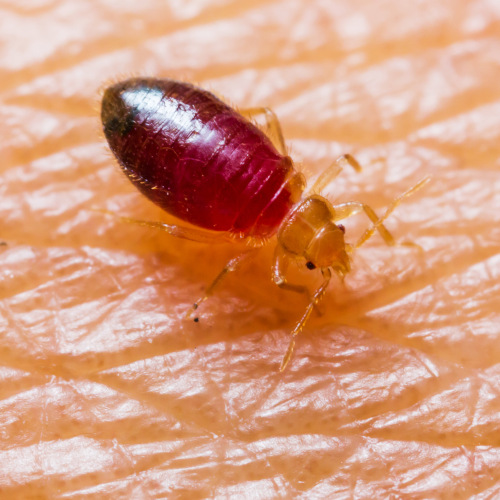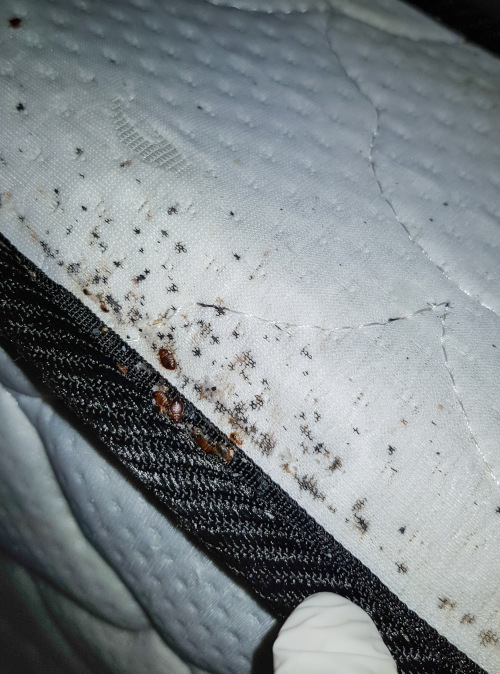Preventing Bed Bugs at Home from Travelling (Step-By-Step)
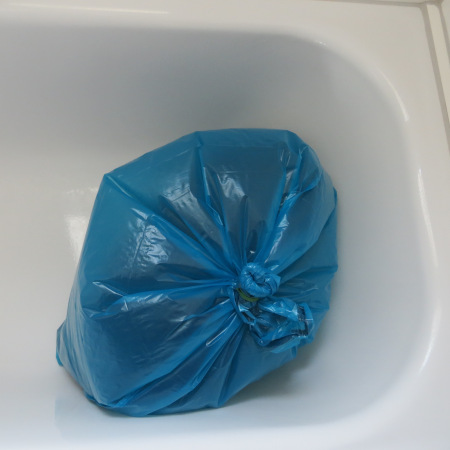
What to do step-by-step upon returning home from traveling if you suspect or really have picked up bed bugs. And how to prepare before leaving for travel.
The article is structured as follows:
1. Preparation Before Leaving for Travel
Must Preparation:
- Have large plastic bags ready at home (see below)
Optional:
2. How to Identify Bed Bugs
How to Recognize Bites

Bed bugs usually bite while you are asleep and that is usually at night.
They tend to take multiple bites that form a a line.
The first picture shows what it looks like after being bitten at night. You can see that three of the bites are characteristically lined up.
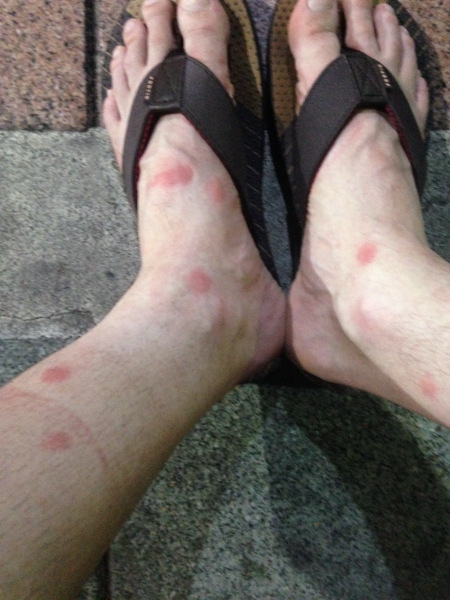
The second picture was taken a day later.
How to Recognize Bugs Themselves
Bed bugs can be seen by the naked eye. They usually look like in the picture.
The shape of their body changes when they feed on blood. The body becomes longer as visible in the second bug picture.
How to Recognize Signs on Mattress
It is advisable to check the beds one sleeps in while travelling for signs of bed bugs. The picture here shows very strong signs of bugs. The signs are: dark poop stains, empty skin shells, and small white eggs. The picture here also contains living bugs.
3. What to Do When Returning Home Step-By-Step
This section describes how to deal with bed bugs. If you are returning home and you suspect bedbugs or know that you or your luggage might be contaminated, then follow these steps:
1. Put Everything Into Plastic Bags
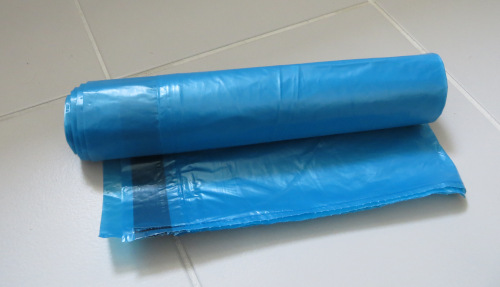
Immediately upon arriving home put everything into large plastic bags. This includes everything you are wearing. Do it outside or if you cannot, then stand into the bathtub and do it there (in that case do not even take your shoes of before you are in the bathtub).
Always have a roll of plastic bags ready at home before you leave for travelling.
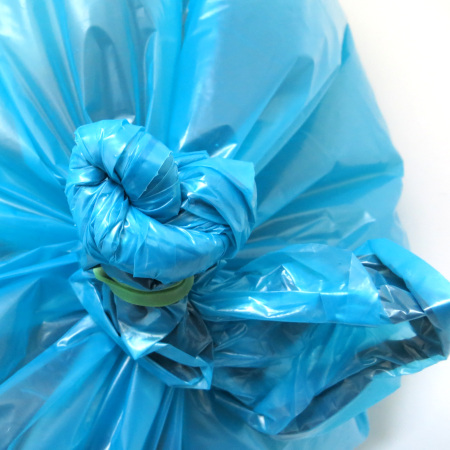
Bed bugs can be very small and very thin. They are known to crawl through very small cracks in walls. So close bags well (twist many, many times or use some other procedure). The bags must be absolutely airtight.

Put the bags somewhere outside the house if you can. Or else store them in the bathtub.
2. Take a Shower
Have a shower and clean yourself well.
3. Working Through the Items in the Plastic Bags
Each item in the bags must now be cleaned of bugs. There are different techniques available:
- Putting it in freezer for 4 days at 0 °F (-17.8 °C)
- Washing clothes at 140 °F (60 °C)
- Heating it with hot air (heating box or similar)
- Starvation
- Other treatments
- Do nothing and take the risk
For each item must be decided how to treat it. The different techniques are described in detail further below in the article.
Shoes
Shoes have glue that would be destroyed if heated in any ways. Therefore, shoes are to be frozen.
Clothing
Some clothes of it can be washed in a washing machine at 140 °F (60 °C). But the clothes might shrink and in that case, it is better to freeze them.
Wallet (Purse)
Take cards and other sensitive stuff out and put the rest in the freezer.
Books, Papers
Freeze them
Luggage
Hot air treatment, starvation treatment, or some other treatment
Backpacks
They are usually too large for a washing machine and are made out of plastic fabrics that cannot stand the heat and might even damage the washing machine. The treatments are, therefore, the same as for other luggage bags: hot air treatment, starvation treatment, or some other treatment.
Electronics
They are a problem. They cannot be frozen without risk and not be heated without risk. Fortunately, most electronics leave little room for bugs to crawl into. Notebooks are among the most problematic, because they have ventilation holes. Possible treatments include:
- One can try to very cautiously take all dirt out of USB ports with toothpicks and similar.
- One can also leave them a few days in a bag together with much (used) clothes in hope that any bug would crawl out of the electronics and into the clothing. According to other sources in the internet, electronics are not the preferred hiding spot for bugs, so they might take that chance to get out of it. And then treat the clothing.
- An alternative is placing them in a bag with poisonous stripes.
- If you do not need the item for a longer time period (0.5 to 1 year), then starvation treatment is possible.
But basically, there is no really easy and good solution for electronics, so one might end up taking risk here. But be very sure to at least freeze any removable cases of the electronics.
4. Bed Bug Treatments in Detail
Freezing
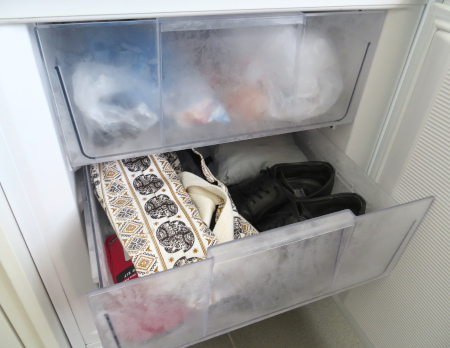
Freezing is a good solution for most items. It does not damage them and many people have a freezer available.
The temperature has to be 0 °F (-17.8 °C) for 3.5 days1. Items should be bagged airtight before being placing in the freezer to avoid bugs crawling out surviving elsewhere in the freezer as well as it protects the items against water condensation damage. 1
Heat Treatment
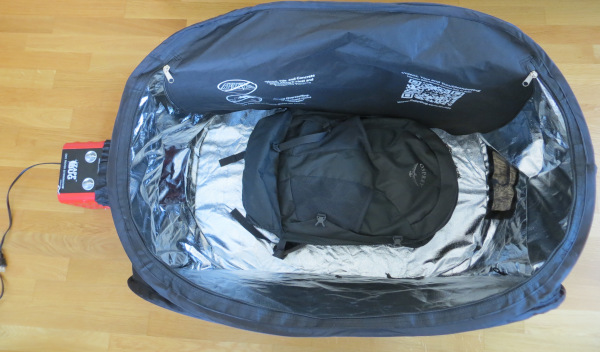
ZappBug sells heating boxes. The model shown on the left is the ZappBug Heater. Some companies also rent them out.
The temperatures to kill all bed bugs and eggs is around 120 to 131 °F (49 to 55 °C). The exact temperature depends on the exposure time.2
ZappBug writes in its manual to place the thermometer at the deepest (most insulated) part of the luggage and wait until the temperature reaches 120 °F (49 °C) and then let it run for 60 minutes or longer.3
Washing Clothes
The temperature for washing clothes must be set to at least 140 °F (60 °C). Choose a program that runs for at least 60 minutes, preferably even longer. As the washing machine is not a precise scientific device, it might not actually reach the temperature on the settings knob. Therefore, washing it twice might be a good idea.
Keep in mind that this is too hot for many pieces of clothing and that putting them in the freezer is often a better choice.
Starvation Treatment
Bed bugs can survive starvation up to 142.6 days.4
Bag or otherwise encase the items completely airtight and store it away for 1 year.
Ultralow Oxygen and Vacuum Treatments
If you happen to have such tools at home, then they can be very effective5.
Vacuum does not mean vacuum cleaner, but the total removal of air.
The ultralow oxygen treatment can be made by flushing a sealed enclosure with nitrogen gas and can be very effective5. Since the normal air is made up of around 78% nitrogen, it is a non-toxic solution. The treatment time is reduced significantly if the enclosure is heated up slightly. It is possible to kill all bugs and eggs within 8h at 0.1% oxygen (meaning approx. 99.9% nitrogen) and 86 °F (30 °C). But since such low oxygen levels have to be constantly maintained, it might not be a solution for usage at home. And it is not common to be used.
Steamer Treatment
It is also possible to treat items with hot steam6. But people usually do not have a steamer at home. If spending money, then the air heat treatment box is probably the better choice, as steam is very hot and, therefore, can do more damage to items than an air heat treatment box.
Poison
Insecticide resistance of bed bugs is a problem7.
The use of poison might also have negative effects on human health.
The use of toxic gases inside the plastic bags might be possible.
There are strips sold that slowly diffuse poisonous gas. There must be sufficient free air space within the bag for the gases to be able to travel around. If you search for "bed bug strips" some results should come up. An example is Nuvan ProStripes that contain DDVP (2,2-dichlorovinyl dimethyl phosphate).
A pest control expert should know more.
Interceptor Traps
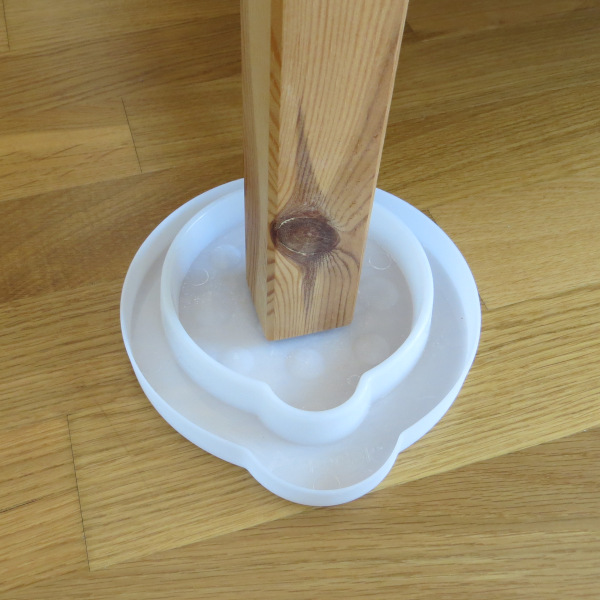
There are interceptor traps available. The bugs get trapped when they try to crawl up or down your bed or some other furniture. The trap sellers write that this is only a measure to check whether you have bugs or not, but not a way to fight them. As the bugs can survive 150 days without any blood, you would have to make it impossible for any of the bugs to feed on anyone in your home for these 150 days. If only one bug gets a meal then the 150 days start over again. It is very unlikely that this strategy would be successful, so these interceptor traps are really is not a solution by themselves.
5. Other
Bed bugs are currently not known to be spreading diseases to humans.8
Published:
Last modification:


